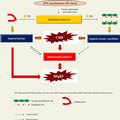Abstract and Introduction
Abstract
Coronary microvascular disease (CMD), characterized by impaired coronary flow reserve (CFR), is a common finding in patients with stable angina. Impaired CFR, in the absence of obstructive coronary artery disease, is also present in up to 75% of patients with heart failure with preserved ejection fraction (HFpEF). Heart failure with preserved ejection fraction is a heterogeneous syndrome comprising distinct endotypes and it has been hypothesized that CMD lies at the centre of the pathogenesis of one such entity: the CMD–HFpEF endotype. This article provides a contemporary review of the pathophysiology underlying CMD, with a focus on the mechanistic link between CMD and HFpEF. We discuss the central role played by subendocardial ischaemia and impaired lusitropy in the development of CMD–HFpEF, as well as the clinical and research implications of the CMD–HFpEF mechanistic link. Future prospective follow-up studies detailing outcomes in patients with CMD and HFpEF are much needed to enhance our understanding of the pathological processes driving these conditions, which may lead to the development of physiology-stratified therapy to improve the quality of life and prognosis in these patients.
Graphical Abstract
The mechanistic link between coronary microvascular disease and heart failure with preserved ejection fraction.
Introduction
Up to half of patients with angina and non-obstructive coronary artery disease (NOCAD) have evidence of coronary microvascular disease (CMD).[1] Coronary microvascular disease is defined as an abnormality in the microcirculation leading to an inadequate vasodilatory response, or a pathological vasoconstrictive response, to physiological or pharmacological stress.[2] Coronary microvascular disease can be due to endothelial and/or vascular smooth muscle (VSM) (endothelium-independent) dysfunction. Contemporary invasive tests used to diagnose CMD are based on assessing the ability of the microvasculature to augment blood flow in response to a vasodilator stimulus, i.e. the flow reserve.[3–5] Endothelium-independent CMD is defined as a coronary flow reserve (CFR) of <2.5 in response to adenosine, whereas endothelium-dependent CMD is defined as acetylcholine flow reserve of <1.5 in response to acetylcholine.[4,6] In the context of NOCAD, diminished CFR and/or acetylcholine flow reserve is associated with inducible ischaemia, impaired quality of life, and increased risk of adverse cardiovascular outcomes.[7–11] There is emerging evidence linking coronary microvascular dysfunction to heart failure with preserved ejection fraction (HFpEF),[12–14] with up to 75% of patients with HFpEF suffering from impaired CFR despite the absence of obstructive coronary artery disease.[15] Heart failure with preserved ejection fraction is a heterogeneous syndrome characterized by exercise intolerance. The contemporary cognizance is that HFpEF, like NOCAD, is an umbrella term comprising distinct endotypes, each with disparate underlying pathophysiology, therapeutic targets, and prognosis. Coronary microvascular disease-related HFpEF (CMD–HFpEF) represents one distinct endotype (Figure 1). In this review article, we will discuss the mechanistic role played by CMD in the pathogenesis of CMD–HFpEF, including abnormalities in cardiac–coronary coupling, which underlie the intimate relationship between myocardial perfusion and diastolic function.
Figure 1.
This figure illustrates that heart failure with preserved ejection fraction is a heterogeneous syndrome comprising distinct endotypes, each with disparate underlying pathophysiology, therapeutic options, and outcomes. Patients can be characterized clinically according to factors such as pathophysiology (A), or they can be characterized using artificial intelligence-derived clusters that groups patients according to their clinical characteristics and clinical outcomes (B). Note: (B) is illustrative and not based on real data. CMD, coronary microvascular disease; HFpEF, heart failure with preserved ejection fraction.



